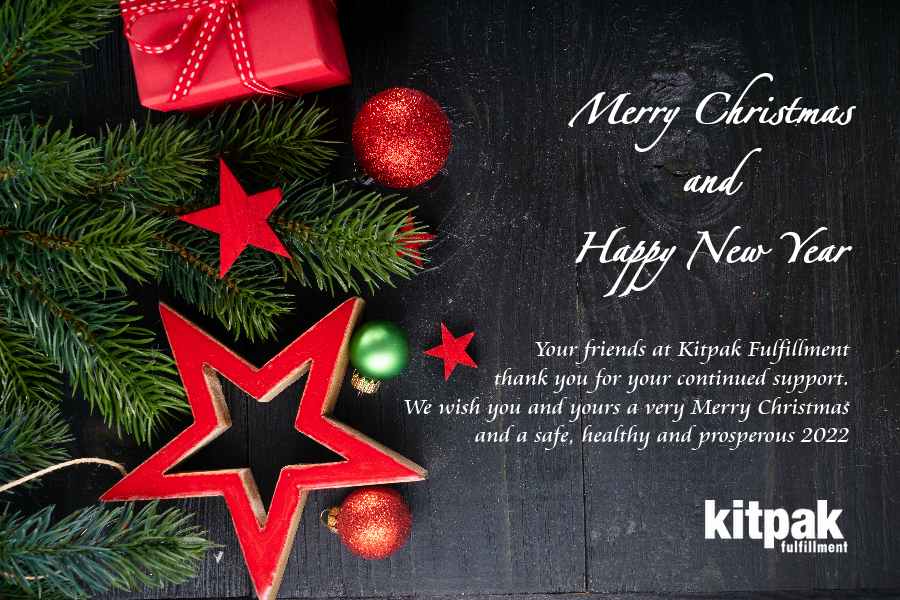

It is that time of year when sales ramp up and your customers rely on you more than ever, to get their order delivered before Christmas. Kitpak Fulfillment wants you to know that the cut off dates for Christmas 2021 delivery published by many carriers are for use as a guideline only.
This year, extenuating circumstances may impact the normal holiday season delivery schedules for many carriers. Heavy rains from atmospheric rivers have caused severe flooding, mud slides and highway/railway washouts in British Columbia and the Maritime provinces. This has resulted in a significant backlog of freight that will take some time to clear, compounding an already backlogged and stressed supply chain.
With the uncertainty in the supply chain and weather events caused by factors out of their control, most carriers will provide some guidance on cut-off dates for Christmas 2021 delivery, but without the normal guarantee.
Here are the Christmas shipping cut-off dates from several carriers. For further information about cut off dates for Christmas 2021 delivery, please contact Kitpak Fulfillment today.




The Kitpak Fulfillment distribution center in Winnipeg, Manitoba is ideally located for reaching all points in North America quickly and inexpensively. To find out more about how Kitpak Fulfillment can help you meet your customer delivery commitments, please contact us today.

1615 Inkster Blvd.
Winnipeg, Manitoba R2X 1R2
(204) 471-8251
sales@kitpak.com

One of the frequently asked questions our clients ask is “How do I know when to replenish my inventory”? When setting up your inventory replenishment system, there are several factors to consider to help ensure you set your Order Point correctly. Information you will want to consider includes:
There are numerous inventory replenishment methods that can be used from the most basic to the more complicated. Here we will discuss the Order Point system where an inventory replenishment signal is triggered when the balance on hand reaches a predetermined level.
The amount of inventory you choose to maintain needs to satisfy the current demand, the demand over the replenishment lead time and any unexpected variations (safety stock). The amount of safety stock you choose to keep to buffer unexpected demand or replenishment disruption is typically based on historical averages, forecasts and your own risk tolerance.
Other factors
Other factors or variables may need to be considered before making the decision on the inventory reorder quantity. These may include:
Order Point Example
In this scenario, without considering other variables, a replenishment order would be signaled when the inventory first dips below 700 units (21 days of average demand during lead time = 420 units plus safety stock of 14 days = 280 units).
The minimum order quantity would be 420 based upon the expected average demand over the replenishment lead time. Theoretically, another order for 420 would need to be placed about the same time as the first order is received. If demand increases during the order lead time, the next order placed would typically include the MOQ of 420 plus the quantity needed to bring the safety stock back to the desired level.
Click the link below to use our simple calculator to help determine your inventory replenishment order point.
Contact Kitpak Fulfillment today to learn more about how we can help you improve your order fulfillment process and save you money.

1615 Inkster Blvd.
Winnipeg, Manitoba R2X 1R2
(204) 471-8251
sales@kitpak.com

You have worked hard to develop your business and have created a great website and shopping cart for your customers to purchase your products online. While your online sales may be good, you may notice a growing number of shoppers leaving your website before completing their purchase. In fact, an average of 64% of online shoppers who initiate an online purchase will abandon their shopping cart before completing the purchase process. Why does this happen?
To prevent cart abandonment, the best thing an online store owner can do is to facilitate a smooth, quick and easy checkout process for their customer. Anything that interrupts the check-out process creates an opportunity for the shopper to reconsider their purchase and potentially change their mind.
The top reason for cart abandonment is the customer finding higher than expected shipping/handling charges after starting the purchase process. They will stop to reconsider the value and potentially stop the purchase.
What can you do to prevent this? There are many strategies that can be adopted, depending on your particular product, profit margins, ship-to locations, speed to market requirements, etc.
Sometimes, before completing an online purchase, the customer is asked to create an account or to provide their full contact information. Asking for too much information up front can stop a customer from completing their purchase. What can you do to help facilitate a smooth purchase?
Not all online shoppers are visiting your store to make a purchase, many are simply browsing for products or services in which they are interested but are not ready to complete a purchase. They may be researching products, comparing pricing, checking to see if it is in stock, etc. So what can you do to help facilitate an eventual purchase?
Kitpak Fulfillment is a Winnipeg based e-fulfillment partner to Canadian online store owners. To learn more about how Kitpak can help improve your e-fulfillment services while saving you money, reach out to us today. We are ready to help!

1615 Inkster Blvd.
Winnipeg, Manitoba R2X 1R2
(204) 471-8251
sales@kitpak.com